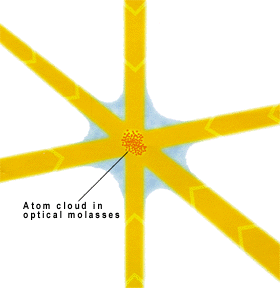
Optical molasses
Encyclopedia

Laser cooling
Laser cooling refers to the number of techniques in which atomic and molecular samples are cooled through the interaction with one or more laser light fields...
technique that can cool down neutral atom
Atom
The atom is a basic unit of matter that consists of a dense central nucleus surrounded by a cloud of negatively charged electrons. The atomic nucleus contains a mix of positively charged protons and electrically neutral neutrons...
s to temperatures colder than a magneto-optical trap
Magneto-optical trap
A magneto-optical trap is a device that uses both laser cooling with magneto-optical trapping in order to produce samples of cold, trapped, neutral atoms at temperatures as low as several microkelvins, two or three times the recoil limit.By combining the small momentum of a single photon with a...
(MOT). An optical molasses consists of 3 pairs of counter-propagating circularly polarized laser beams intersecting in the region where the atoms are present. The main difference between optical molasses and a MOT is the absence of magnetic field in the former. While a typical Sodium MOT can cool atoms down to 300μK, optical molasses can cool the atoms down to 40μK, an order of magnitude colder.
History
When laser cooling was proposed in 1975, a theoretical limit on the lowest possible temperature was predicted. Known as the Doppler Limit, , this was given by the lowest possible temperature attainable considering the cooling of two-level atoms by Doppler cooling and the heating of atoms due to momentum diffusion from the scattering of laser photons. Here,
, this was given by the lowest possible temperature attainable considering the cooling of two-level atoms by Doppler cooling and the heating of atoms due to momentum diffusion from the scattering of laser photons. Here,  , is the natural line-width of the atomic transition,
, is the natural line-width of the atomic transition,  , is Planck's constant and,
, is Planck's constant and,  , is Boltzmann's constant.
, is Boltzmann's constant.Experiments at the National Institute of Standards and Technology
National Institute of Standards and Technology
The National Institute of Standards and Technology , known between 1901 and 1988 as the National Bureau of Standards , is a measurement standards laboratory, otherwise known as a National Metrological Institute , which is a non-regulatory agency of the United States Department of Commerce...
, Gaithersburg, found the temperature of cooled atoms to be well below the theoretical limit. Initially, it was a surprise to theorists, until the full explanation came out.
Theory
The best explanation of the phenomenon of optical molasses is based on the principle of polarization gradient cooling. Counterpropagating beams of circularly polarized light cause a standing wave, where the light polarization depends on the spatial location. The AC Stark ShiftStark effect
The Stark effect is the shifting and splitting of spectral lines of atoms and molecules due to presence of an external static electric field. The amount of splitting and or shifting is called the Stark splitting or Stark shift. In general one distinguishes first- and second-order Stark effects...
of atoms in different magnetic sub-levels
Fine structure
In atomic physics, the fine structure describes the splitting of the spectral lines of atoms due to first order relativistic corrections.The gross structure of line spectra is the line spectra predicted by non-relativistic electrons with no spin. For a hydrogenic atom, the gross structure energy...
is also spatially dependent. The basic idea is that atoms moving with a velocity climb a polarization gradient hill, thereby losing their velocity. At the top of the hill, atoms are resonant with the other molasses beams, absorb a photon and decay into a lower energy magnetic sub-level, thereby having shed some of their velocity.

